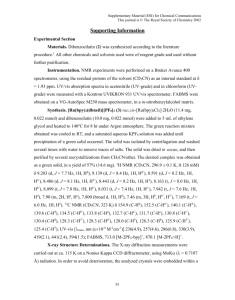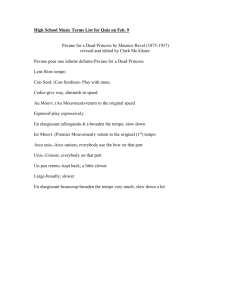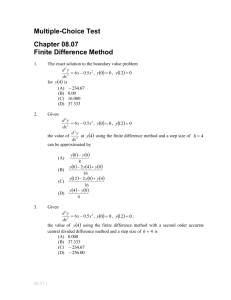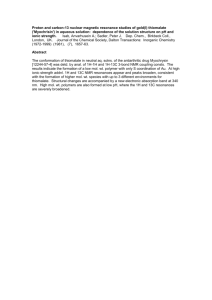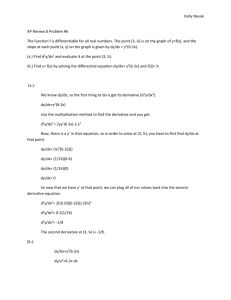12CE nick and Jessica SI1 - Shannon S. Stahl
advertisement
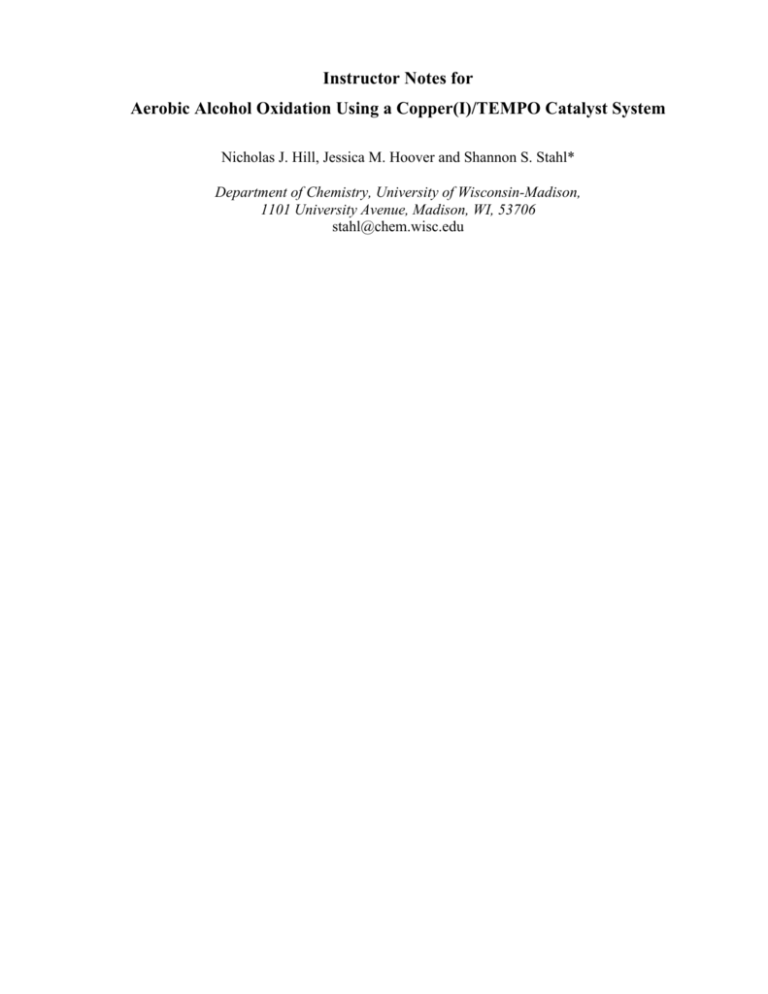
Instructor Notes for Aerobic Alcohol Oxidation Using a Copper(I)/TEMPO Catalyst System Nicholas J. Hill, Jessica M. Hoover and Shannon S. Stahl* Department of Chemistry, University of Wisconsin-Madison, 1101 University Avenue, Madison, WI, 53706 stahl@chem.wisc.edu Instructor Notes for Aerobic Alcohol Oxidation Using a Copper(I)/TEMPO Catalyst System R OH [CuBr/bpy/TEMPO] R O NMI, acetone Students work in pairs to synthesize a para-­‐substituted benzaldehyde via aerobic oxidation of an unknown benzyl alcohol with a [CuBr/bpy/TEMPO] catalyst system in the presence of NMI in acetone solution. This experiment is based upon a recent report from the Stahl group (J. Am. Chem. Soc. 2011, 133, 16901-­‐16910). Alerts The reaction mixture will turn from colorless to green upon addition of solid CuBr to the acetone solution of 4-­‐R-­‐C6H4CH2OH, it will turn deep red-­‐brown upon addition of bpy and TEMPO, and then it will fade to a lighter red-­‐brown on addition of NMI. Some students interpret the fading in the final step to be the color change mentioned in the lab procedure and proceed to quench the reaction before it has begun. This is not the color change we are looking for! A color change from red-­‐brown solution to a turbid green mixture signifies the consumption of BnOH (except for R= iPr – some starting BnOH may appear in the 1H-­‐ NMR spectrum of the product even though the reaction mixture is green-­‐blue). Students should stir the reaction for an additional 5 min following the color change from red-­‐ brown to green while they set up the work-­‐up and purification steps. Extraction with pentane should give a pale pink organic layer (residual TEMPO) and a blue aqueous layer ([Cu(bpy)(OH)]2Br2 complex). Hexanes was tested as the extraction solvent; however, some of the aldehydes precipitated from this solvent in the separatory funnel, so pentane is recommended. The student lab manual recommends stirring the extract for 10 min over MgSO4; this time period is long than necessary, but it allows the student time to set up their glassware for the filtration. The 4-­‐chloro-­‐ and 4-­‐bromobenzaldehyde products are solids, while the 4-­‐Me-­‐, 4-­‐OMe and 4-­‐iPr derivatives are oils. All products could be tinged slightly red-­‐pink on account of residual TEMPO. If TEMPO is present in sufficient amount, it will broaden the NMR signals of the product. Yields should be >50%, and ideally will approach 90+%. Background and discussion The procedure will be distributed to students as a handout via email and Learn@UW. The oxidation of alcohols is discussed in Loudon pp. 459-­‐461 (1o, 2o, 3o) and pp. 803-­‐805 (allylic and benzylic). As with the Suzuki-­‐coupling lab, this experiment is a means to make students aware that metals can be used to do some interesting and/or otherwise unattainable chemistry. Refer to page 2 of the Suzuki TA notes for a general outline of the level at which you should discuss these concepts. While this laboratory is pitched as a structure-­‐ determination puzzle, students can also appreciate that the Cu/TEMPO oxidation is an example of modern research applied to improving the utility and environmental profile of an important fundamental organic reaction. This chemistry is <12 months old and thus they are doing research-­‐level practical work in an undergrad lab – this may inspire some students! Underline the fact that TEMPO is a commercially available free radical that exists as a stable solid! Shown below is a simple electron-­‐pushing mechanism for the oxidation of the Cu-­‐bound alkoxide (i.e. formation of the aldehyde, and reduction of CuII to CuI and TEMPO to TEMPOH) – this is a good opportunity to illustrate that "organic chemistry" is still happening. Me N + Br- + Br- N N N CuI O Ar Me N CuII N N N O + + Ar OH N H •O N H H TEMPO Lab report Students will use the provided 1H-­‐ and 13C-­‐NMR, EI-­‐MS, and % elemental composition data to determine the structure of the starting benzyl alcohol (see following page for list of unknowns and spectral data) and then confirm the structure of the corresponding benzaldehyde by 1H-­‐NMR and MS data. Students may experience some confusion on how to calculate the formula of the alcohol from the % elemental composition data, but this is a General Chemistry concept that should not be a problem for students (see the example on the following page). Example calculation for determining formula from elemental composition For unknown B: Molecular mass 122.18 g/mol 78.64% C #C-­‐atoms = (0.7864 x 122.18 g/mol) ÷ 12.01 g/mol = 8 8.27% H #H-­‐atoms = (0.0827 x 122.18 g/mol) ÷ 1.01 g/mol = 10 13.09% O #O-­‐atoms = (0.1309 x 122.18 g/mol) ÷ 16.00 g/mol = 1 Unknown B = C8H10O -­‐ this formula can be confirmed via 1H-­‐ and 13C-­‐NMR data THIS IS A GENCHEM CALCULATION THAT STUDENTS SHOULD BE ABLE TO HANDLE PLEASE DO NOT REVEAL THE FORMULAE TO YOUR STUDENTS! Unknown A R = Cl, 2.5 mmol = 357 mg Molecular mass: 142.64 g/mol, C7H7OCl Elemental composition: 58.95 % C; 4.97 % H; 11.23 % O, 24.85 % Cl 1H-­‐NMR: δ 2.70 (s, 1H); 4.50 (s, 2H); 7.29 (d, 2H); 7.21 (d, 2H). 13C-­‐NMR: δ 64.13; 128.23; 128.63; 133.22; 139.12 EI-­‐MS: m/z 144 (23%); 142 (70%) 107 (100%) Unknown B R = Me, 2.5 mmol = 305 mg Molecular mass: 122.18 g/mol, C8H10O Elemental composition: 78.64% C; 8.27% H; 13.09% O 1H-­‐NMR: δ 2.31 (s, 3H); 2.35 (s, 1H); 4.55 (s, 2H); 7.10 (d, 2H); 7.21 (d, 2H). 13C-­‐NMR: δ 21.09; 64.58; 127.12; 129.01; 136.89; 138.04 EI-­‐MS: m/z 122 (87%); 107 (100%), 91 (53%) Unknown C R = Br, 2.5 mmol = 468 mg Molecular mass: 187.04 g/mol, C7H7OBr Elemental composition: 44.95 % C; 3.78 % H; 8.55 % O, 42.72 % Br 1H-­‐NMR: δ 2.44 (s, 1H); 4.54 (s, 2H); 7.17 (d, 2H); 7.44 (d, 2H) 13C-­‐NMR: δ 64.28; 121.35; 128.54; 131.52; 139.73 EI-­‐MS: m/z 188 (56%); 186 (58%); 157 (18%); 155 (10%); 107 (100%) Unknown D R = iPr, 2.5 mmol = 376 mg Molecular mass: 150.24 g/mol, C10H14O Elemental composition: 79.94 % C; 9.41 % H; 10.65 % O 1H-­‐NMR: δ 1.23 (d, 6H); 2.28 (s, 1H); 2.89 (sept, 1H); 4.57 (s, 2H); 7.18 (d, 2H); 7.26 (d, 2H) 13C-­‐NMR: δ 24.04; 34.02; 64.92; 126.56; 127.24; 138.44; 148.28 EI-­‐MS: m/z 150 (49%); 135 (100%); 119 (31%) Unknown E R = OMe, 2.5 mmol = 345 mg Molecular mass: 138.18 g/mol, C8H10O2 Elemental composition: 69.53 % C; 7.31 % H; 23.16 % O 1H-­‐NMR: δ 2.58 (s, 1H); 3.75 (s, 3H); 4.53 (s, 2H); 6.83 (d, 2H); 7.23 (d, 2H). 13C-­‐NMR: δ 55.32; 64.83; 114.20; 128.48; 133.73; 159.50 EI-­‐MS: m/z 138 (100%); 107 (26%) Post-­lab answer key 1) Over-­‐oxidation of the aldehyde results in formation of the corresponding carboxylic acid. 1H-­‐NMR spectrum: expect to see a broad signal in 10-­‐13 ppm region (much broader than the aldehyde signal) (1 pt) and small variation (~0.2 ppm) in chemical shift of aromatic signals. IR spectrum: Strong broad feature spanning ~3300-­‐2600 cm-­‐1 due to H-­‐bonding between RCO2H molecules (don’t need to mention this for credit); also C=O stretch in range 1760-­‐1690 cm-­‐1 for acid vs. 1740-­‐1710 cm-­‐1 for aldehyde (wavenumber ranges can be approximate but should be close to values stated). (1pt). 2) The product can be formed by a combination of imine formation and Suzuki cross-­‐ coupling (either order of the reactions is fine). NH2 Br S Br O N Imine formation Me B(OH)2 Pd cat. Base Suzuki coupling N S A Me The CHEM 344 Suzuki-­‐coupling conditions would most likely not work (would probably need a boronic ester or trifluoroborate salt, a [Pd/ligand] system, a different base, an exotic solvent and heat) but the goal is for students to recognize the biaryl unit and know that Suzuki coupling is a viable method to access it. Anything that looks similar to the above scheme is fine – students need to show the correct aniline and the correct thiophenylboronic acid (1 pt each), and correctly name each reaction (1 pt each). 3a) The data reveal that the dihedral angles decrease in the order cis-­‐bpy > 2,2’-­‐ bipyrimidine > trans-­‐bpy (θ = 35.1 o, 28.3 o, 0.0 o respectively (2 pts); for reference, θ = 38.4o in biphenyl). b) The above trend is likely due to the decrease in steric repulsions by substitution of the ortho C-­‐H groups by N-­‐atoms. The calculations provide evidence that the lone pairs of the N-­‐atoms in bpy and 2,2’-­‐bipyrimidine occupy less space than a C-­‐H bond in biphenyl (somewhat contrary to the VSEPR theory that students typically learn). (3 pts – be generous) The close proximity of the N-­‐lone pair of one aryl ring to a H-­‐atom on the other ring in trans-­‐bpy allows the formation of a stabilizing electrostatic interaction. This structural factor stabilizes the planar (θ = 0o) geometry of trans-­‐bpy, allowing for enhanced conjugation of the π-­‐systems relative to cis-­‐bpy, 2,2’-­‐bipyrimidine and biphenyl (3 pts for a statement mentioning some kind of stabilizing interaction). Such an interaction is not observed in either cis-­‐bpy or bpym, which exhibit H-­‐H or lone pair-­‐lone pair repulsions in a planar conformation. cis-­‐bpy bpym trans-­‐bpy π-­‐MO diagrams of optimized B3LYP/6-­‐31G(d) structures of cis-­‐bpy (MO #30), bpym (MO #29), and trans-­‐bpy (MO #30). Compound CAS Number 2,2'-­‐Bipyridyl (bpy) 366-­‐18-­‐7 Copper(I) bromide 7787-­‐70-­‐4 N-­‐Methyl imidazole (NMI) 616-­‐47-­‐7 (2,2,6,6-­‐Tetramethylpiperidin-­‐1-­‐yl)oxyl (TEMPO) 2564-­‐83-­‐2 4-­‐Bromobenzyl alcohol 873-­‐75-­‐6 4-­‐Bromobenzaldehyde 1122-­‐91-­‐4 4-­‐Chlorobenzyl alcohol 873-­‐76-­‐7 4-­‐Chlorobenzaldehyde 104-­‐88-­‐1 4-­‐Isopropylbenzyl alcohol 536-­‐60-­‐7 4-­‐Isopropylbenzaldehyde 122-­‐03-­‐2 4-­‐Methoxylbenzyl alcohol 105-­‐13-­‐5 4-­‐Methoxybenzaldehyde 123-­‐11-­‐5 4-­‐Methylbenzyl alcohol 589-­‐18-­‐4 4-­‐Methylbenzaldehyde 104-­‐87-­‐0 67-­‐64-­‐1 865-­‐49-­‐6 Magnesium sulfate (anhydrous) 7487-­‐88-­‐9 Pentane 109-­‐66-­‐0 Water 7732-­‐18-­‐5 Acetone Deuterochloroform Hazards The substituted benzyl alcohols and benzaldehydes used in this experiment are irritants and harmful if ingested. Copper(I) bromide, TEMPO, and NMI are corrosive. 2,2'-Bipyridine is toxic if ingested. Acetone and pentane are flammable. Appropriate personal protective equipment such as protective gloves, goggles and lab coats should be worn at all times. Solid and liquid waste should be disposed into appropriately labeled containers. The aerobic oxidation reactions presented herein employ organic solvents in the presence of air; therefore, precautions appropriate for the handling of flammable solvents (acetone, pentane) should be employed Compound Specific Hazard Statement 2,2'-­‐Bipyridyl (bpy) H301 + H311 Copper(I) bromide H315-­‐H319-­‐H335 N-­‐Methyl imidazole (NMI) H301 + H311 (2,2,6,6-­‐Tetramethylpiperidin-­‐1-­‐yl)oxyl (TEMPO) H314 4-­‐Bromobenzyl alcohol None available 4-­‐Bromobenzaldehyde H302-­‐H315-­‐H319-­‐H334-­‐H335 4-­‐Chlorobenzyl alcohol None available 4-­‐Chlorobenzaldehyde H302-­‐H315-­‐H319-­‐H335 4-­‐Isopropylbenzyl alcohol H302-­‐H315 4-­‐Isopropylbenzaldehyde H302-­‐H315-­‐H319-­‐H335 4-­‐Methoxylbenzyl alcohol H302-­‐H315-­‐H319-­‐H335 4-­‐Methoxybenzaldehyde None available 4-­‐Methylbenzyl alcohol H315-­‐H319-­‐H335 4-­‐Methylbenzaldehyde H302-­‐H315-­‐H319-­‐H335 H225-­‐H319-­‐H336 Deuterochloroform H302-­‐H315-­‐H351-­‐H373 Pentane H225-­‐H304-­‐H336-­‐H411 None available Acetone Magnesium sulfate (anhydrous)
